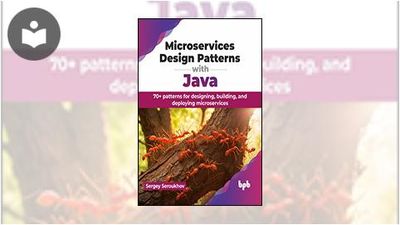Microservices Design Patterns with Java: 70+ Patterns for Designing, Building, and Deploying Microservices
- 6h
- Sergey Seroukhov
- BPB Publications
- 2024
Microservices, a popular software architecture style, breaks down applications into small, independent services built with Java, a versatile and widely used programming language. This book serves as a roadmap for mastering design patterns that solve common problems encountered during microservices development in Java.
Start with microservices setup for team success. Discover various architectural styles and communication approaches for seamless service interaction. Learn effective data management within microservices. Acquire skills for handling unforeseen scenarios in transactions and crafting secure APIs for user service access. Lastly, grasp crucial monitoring, testing, and deployment practices to identify and address issues, ensuring smooth production deployment.
"Microservices Design Patterns with Java" positions itself as an indispensable tool in the arsenal of today’s software professionals. It not only aids in navigating the complexities of microservices architecture but also enhances the reader's ability to deliver robust, high-quality software solutions efficiently.
KEY FEATURES
- Covers 70+ Java microservices patterns in detail.
- Practical code examples for immediate application.
- Strategies from architecture to deployment explained.
WHAT YOU WILL LEARN
- Architect scalable, resilient microservices using Java-based design patterns.
- Implement efficient communication and data management strategies within microservices.
- Design secure, robust external APIs for microservices integration and interaction.
- Monitor and maintain microservices with advanced logging, tracing, and health checks.
- Deploy microservices with Docker, Kubernetes, and serverless platforms effectively.
- Automate CI/CD pipelines for microservices for streamlined development and deployment.
WHO THIS BOOK IS FOR
This book is for seasoned microservices developers seeking to expand their repertoire of design patterns and practices, as well as for newcomers looking for comprehensive guidance on patterns and practices throughout the entire development lifecycle. It is tailored for architects, developers, team leads, and DevOps engineers.
About the Author
Sergey Seroukhov, a passionate Technology Evangelist, resides in Tucson, AZ, with his wife Natalya and two children, Michael and Alexandra. He is the visionary founder of Enterprise Innovation Consulting, a boutique consulting firm that empowers development teams to embrace modern development methods, enhance productivity, reduce costs, accelerate time to market, and foster innovation.
Enterprise Innovation Consulting(https://www.entinco.com/) was founded in 2016, driven by the dream of helping software teams build more and better software faster. With his group of talented engineers, Sergey assisted multiple organizations in developing complex enterprise systems utilizing microservices, microfrontends, and DevOps. Moving the business to the next level, Enterprise Innovation Consulting, under Sergey’s leadership, created several programs called “Better Microservices (https://www.entinco.com/programs/better-microservices),” “Better Microfrontends (https://www.entinco. com/programs/better-microfrontends),” “Better Delivery (https://www.entinco.com/ programs/better-delivery),” and “Better Testing (https://www.entinco.com/programs/ better-testing)” that aimed at drastically improving development productivity through standardization of architecture and implementation of development patterns and practices. Moreover, all those programs represented the 1st step toward the “Software Factory”, a new development model that brings a step-change in productivity and cost reduction through standardization, deeper specialization of labor, and conveyor-like development processes. Emerging Generative AI combined with the Software Factory (https://www.entinco. com/programs/software-factory) model represents a perfect fit, allowing the systematic and incremental increase of automation in software development until it finally reaches the “Light-off Factory” state when most of the software is generated automatically. The world is not there yet, but the work of visionaries like Sergey Seroukhov and companies like Enterprise Innovation Consulting are making that future come sooner.
Sergey's journey in coding began at the age of 14, and he implemented his first commercial software product using dBase around 1991, even before graduating from high school. After completing his master's degree at Donetsk State Technical University in 2001, he embarked on a new chapter in the United States with his wife, Natalya. Over the next two decades, Sergey honed his skills, working as a Software Developer, Team Lead, Solution Architect, and eventually as a CTO in several startups. His foray into microservices started around 2005, leading the creation of a distributed system architecture composed of loosely coupled services and composable frontends. Since 2012, when microservices gained recognition, he has been instrumental in the development of numerous microservices systems, using a wide range of programming languages like .NET, Java, Node.js, Go, Python, and Dart.
In this Book
-
Code Bundle and Coloured Images
-
Defining Product Vision and Organization Structure
-
Architecting Microservices Systems
-
Organizing and Documenting Code
-
Configuring Microservices
-
Implementing Communication
-
Working with Data
-
Handling Complex Business Transactions
-
Exposing External APIs
-
Monitoring Microservices
-
Packaging Microservices
-
Testing Microservices
-
Scripting Environments
-
Automating CI/CD Pipelines
-
Assembling and Deploying Products



